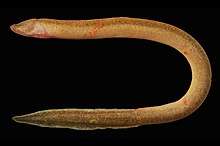Ophisternon bengalense
Ophisternon bengalense the Bengal eel, Bengal mudeel or onegill eel, is a species of fish in the family Synbranchidae. It is endemic to freshwater and brackish water rivers and swamps in the Oceania and South Asia. It is normally 100 cm in maximum length.[2]
| Ophisternon bengalense | |
|---|---|
 | |
| Scientific classification | |
| Kingdom: | Animalia |
| Phylum: | Chordata |
| Class: | Actinopterygii |
| Order: | Synbranchiformes |
| Family: | Synbranchidae |
| Genus: | Ophisternon |
| Species: | O. bengalense |
| Binomial name | |
| Ophisternon bengalense McClelland, 1844 | |
| Synonyms[2] | |
| |
Description
Ophisternon bengalense has an eel-like body with a flattened head with a single slit-like gill opening at the bottom of the back of its head and small eyes which can be seen through its skin. The dorsal and anal fins are reduced and form folds of skin on the rear half of the body, the pectoral and pelvic fins are absent. It can grow t0 55 centimetres (22 in) but is more usually 20 centimetres (7.9 in). The colour is blackish-green to rufous with a purplish tinge and dark spots.[3]
Distribution
Ophisternon bengalense is recorded from South Asian countries like India, Bangladesh and Sri Lanka to south-eastern Asia, Indonesia, Philippines and New Guinea. The fish may also found in Australia and Palau islands.[2]
Biology and habitat
Ophisternon bengalense has an almost unknown biology, it is thought likely to be a protogynous hermaphrodite which lays eggs in a tunnel excavated into the soft substrate.[3] The males excavate and guard the nesting burrow. The adults may be found in both fresh and brackish waters along rivers and in swamps, frequently close to the river mouth. They are normally recorded among thick vegetation in muddy, still water bodies, such as lagoons, swamps, canals and rice fields.[2]
Fisheries
Ophisternon bengalense is of minor interest to fisheries and is eaten.[1] It is normally sold and eaten fresh.[2]
References
- Dahanukar, N. (2010). "Ophisternon bengalense". IUCN Red List of Threatened Species. IUCN. 2010: e.T166410A6203241. doi:10.2305/IUCN.UK.2010-4.RLTS.T166410A6203241.en.
- Froese, Rainer and Pauly, Daniel, eds. (2019). "Ophisternon bengalense" in FishBase. August 2019 version.
- Dianne J. Bray; Vanessa J. Thompson. "Ophisternon bengalense". Fishes of Australia. Museums Victoria. Retrieved 12 November 2019.
Sources
- Wager, R. 1996. Ophisternon bengalense. 2006 IUCN Red List of Threatened Species. Downloaded 4 August 2007.
- http://biodiversityofsrilanka.blogspot.com/p/freshwater-fish-diversity-of-sri-lanka_29.html
